Case Study prepared by Tyesha McGann, History and Theory of Architecture Student, Carleton University
Adaptive Reuse of the Former Bank of Montreal Building, Ottawa: Preserving Integrity While Improving Performance Through Sustainable Rehabilitation
Keywords: Rehabilitation, adaptive reuse, Green Globes, environmental sustainability, Ottawa, federal building
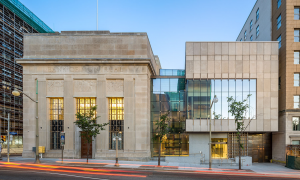
North Façade and Annex. Retrieved from http://mtbarch.com//
LESSONS LEARNED: On Wellington Street within the Parliamentary Precinct, the John A. Macdonald formerly known as the Bank of Montreal has proven to be a successfully integration of old with the new. By minimally intervening with the FHBRO designated heritage building and complementing its character-defining elements with the addition of an Annex and Atrium, its urban heritage value could be interpreted as not only conserved, but reestablished. By adaptively reusing the space and introducing it to new building programs, its federal stewards, the department of Public Works (now renamed Public Services), has efficiently avoided demolishing the building to replace it with new infrastructure. Rather, by bringing together an integrated team of experts, all the conservation and architectural needs were met efficiently, ecologically, and sustainably. As such, the John A. Macdonald building proved to be an interesting and complex building to assess. That being said, this project also highlights certain circumstances in which not everything can be sustained. For instance, in order to reuse this space for parliamentary purposes, they had to sacrifice its importance as a once very public building; one could question how important accessibility should be in such an adaptive reuse. In addition, there was an unbalance amongst environmental, socio-cultural and economic sustainability. Although the building was notably successful for its achievement in incorporating environmentally friendly features that would inevitably reduce its carbon footprint and overall environmental impact, there was also a missed opportunity in preserving the other two pillars.
PRESENTATION: In addition to this following Case Study, the link to the class presentation briefly presents the key points that will subsequently be embellished. It highlights some key points from each section as well as it provides additional images.
DESCRIPTION:
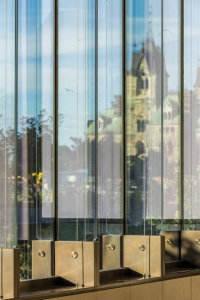
Detail of the Glass fins facing the Atrium, Retrieved from https://s3-ca-central-1.amazonaws.com/
In 1930, construction began at 144 Wellington street (Canadian Register of Historic Places) on what would later be home to the Bank of Montreal, a building distinguished by its combination of classicist massing, beaux-arts planning and Art-Deco accents (Parks Canada, 2016, p.140). For its incredible achievements in harmonious combination of architectural styles, Earnest Barrott the leading architect received a RAIC Gold Medal in 1932 (Brandt, 2016), and in 1986 the Bank of Montreal was designated a heritage building under Federal Heritage Building Review Office (Government of Canada, Public Works and Government Services Canada, and Parliamentary Precinct Branch, 2017). Since its closure as a bank in 2005 (Ryckewaert, 2016), this building has since been adapted to function as an office, conference and ceremonial center, to host large Parliamentary meetings and functions (Green Globes, 2016). It was also renamed the Sir John A. Macdonald Building. These rehabilitation efforts are part of a 99.5-million-dollar contract with Public Services to fix up the Parliamentary Precinct in which this space was intended to replace the Confederation room in the West Block (Ryckewaert, 2016).
Architect David Clusiau of NORR Ltd, in partnership with Ellis Don Corp., and heritage conservationist Mark Brandt from MTBA, were successful in engaging with the original heritage building to accommodate the needs for this new Parliamentary space (Ryckewaert, 2016). In order to do so, this project encapsulated two heritage sustainability processes: rehabilitation and adaptive reuse. The comprehensive rehabilitation efforts involved structural, mechanical, electrical, plumbing, seismic upgrades, and interior refurbishment (Government of Canada, Public Works and Government Services Canada, and Parliamentary Precinct Branch, 2017). It also rehabilitated the interior and exterior stonework and the overall craftsmanship in the wood, plasterwork and ornamentation (Parks Canada, 2016). In terms of adaptive reuse, the architectural and construction efforts ensured a harmonious connection between the additional spaces and their integration into and with the former Bank of Montreal Building (Ryckewaert, 2016). These additional spaces include an Annex, a glass atrium with a new main entrance, new spaces to accommodate conference areas, and new service spaces such as loading dock, washrooms, and service rooms, (Ryckewaert, 2016). These processes epitomized the driving force of a process known as long-life/loose-fit, a concept that advocated for the long life of existing buildings, yet understands that changes in its program are inevitable overtime (Caroon, 2010, p.11). In the case of the Sir John A. Macdonald building, long-life/loose fit is embodied through adaptive reuse, as the narrative of the building is actively being changed through changes in its function all while conserving the integrity, authenticity, and originality of the heritage building.
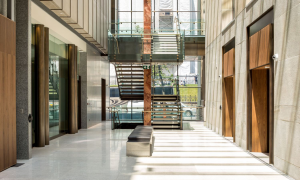
Interior of the atrium, point of connection between Annex and the Heritage Building. Retrieved from http://mtbarch.com/
In conjunction with these additions and rehabilitation effort, the design team took the initiative to approach these changes with a desire to improve its environmental performance and conserve the integrity of the heritage building. As such in an effort to reduce energy consumption of the Parliamentary precinct and the Downtown core, the design addressed issues with its microclimate such as the urban heat island and light pollution (Green Globes, 2016). Overall performance was assessed through the Green Globes rating system, and the Sir John A. Macdonald building received the highest possible rating of five Green Globes. This achievement was in part due to the building’s excellence in energy performance, with an improvement of 21% as well as an estimated energy use of 9, 176 Gj/y (Green Globes, 2016). This achievement was a result of the conservation efforts that were involved, including HVAC systems and energy management, energy efficient lighting and water fixtures, daylighting and sensor control, green rood and optimal orientation to optimize effect of microclimate (Green Globes, 2016). As such, the Sir John A. Macdonald building has become a national and world leader in energy conservation and sustainability in heritage buildings (Government of Canada, Public Works and Government Services Canada. & Parliamentary Precinct Branch, 2017).
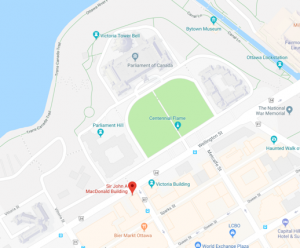
The Parliamentary Precinct, 2017, https://www.google.ca/maps/
TIMELINE: The historic timeline is divided into three categories as a way of coherently presenting and narrating the overlapping events that have occurred on this site.
Building site: 144 Wellington St.
- 1872-1873 – Construction of the first building on site as a part of Sparks Street. (Canadian Registrar of Historic Places)
- 1929 – the demolition of the first building. (Canadian Registrar of Historic Places)
- 1930-1932 – Construction of the Bank of Montreal Branch designed by Earnest Barrott (Government of Canada, Public Works and Government Services Canada. & Parliamentary Precinct Branch, 2017)
- 2005 – The function of the building ceased operating as a bank (Ryckewaert, 2016)
- 2005-2011 – Vacancy (Ryckewaert, 2016)
- 2011-2015 – Construction phase of Sir John A. Macdonald Building rehabilitation (Parks Canada, 2016, p.140, Ryckewaert, 2016)
- 2015 – building handed over to the House of Commons (Ryckewaert, 2016)
Heritage and conservation efforts
- 1986 – Designation as Classified Federal Heritage Building (Government of Canada, Public Works and Government Services Canada & Parliamentary Precinct Branch, 2017)
- 2002 – Green Globes is released in Canada (Caroon, 2010, p.93)
- 2003 – Publication of Conservation Guidelines for the Bank of Montreal
- 2013 – Publication of updated Green Globes for New Construction v.2. (Green Globes, 2014)
Awards
- 1932 – RAIC Green Medal Award (Brandt, 2016)
- 2015 – National Trust Award (Ryckewaert, 2016)
- 2015 – City of Ottawa Urban Design Award (Ryckewaert, 2016)
- 2015 – Achieved rating of 5 Green Globes (Parks Canada, 2016)
- 2015 – City of Ottawa Urban Design Awards (Ryckewaert, 2016)
- 2015 – Corner Stone Award for Heritage Rehabilitation and Adaptive Reuse (Ryckewaert, 2016)
STAKEHOLDERS: As a formerly public building that has been repurposed into a Parliamentary building, the subsequent list of stakeholders has been divided into 3 categories: affiliations with the public and None-Government organization, Engineering and Design, and Federal Government Benefactors.
Public and NGO Affiliations
- Doors Open Ottawa: In June of 2016, door open Ottawa enabled free public access into the John A. Macdonald a year after its reopening. (Ottawa citizen, 2016)
Engineering and Design
- Ellis Don Corp.: as Construction Managers, they were responsible for improving system upgrades within the existing buildings, conservation and rehabilitation of interior and exterior materials, as well as the construction of the green roof, atrium and annex (EllisDon Construction and Building Services, 2016).
- NORR: serviced architectural needs, mechanical and electrical engineering, interior design, and contract administration. Their responsibilities included a full heritage rehabilitation, interior refurbishments, incorporation of new service spaces, and were responsible for the design of the glass atrium and the Annex (NORR Ltd., 2017).
- MTBA: Under the leadership of Mark Brandt, MTBA was responsible for all heritage conservation work that involved engaged with materials, craftsmanship and integrity to ensure the significance of the place informed each process and phase of development (MTBA Associates Inc, 2017).
- John G. Cooke & Associates Ltd.: as structural engineers, they rehabilitated the existing BMO building, improved seismic systems, and oversaw the structural addition of the Annex and its intervention with the heritage building (J. G. Cooke & Associates Ltd.).
Federal Government
- Federal Heritage Building Review Office: Representing the government in the protection of their heritage buildings, in accordance with the Treasury Board Policy on Management of Real Property. They oversee developments that are intended to be occupied by federal governmental departments not those that are associated with Crown Corporations (Parks Canada, 2017).
- House of Commons: Users of this space since the summer of 2015 (Ryckewaert, 2016).
- Public Works and Government Services Canada: as key provider for services for federal department and agencies, they oversee the design and construction processes of all government buildings. (Public Services and Procurement Canada, 2017).
- National Capital Commission (NCC): As federal urban planners within the Capital Region, they ensure that the highest standards of excellence are being upheld in architecture and urban design in terms of environmental sensitivity, sustainability and best practice (National Capital Commission)
CULTURAL HERITAGE: The cultural heritage of the Former Bank of Montreal stems from its importance as a reflection of the time in which it was built. Since it was constructed in th World War II era, Modern buildings alike were intended to respond to the societal changes, new material access, the industrialization, and the new way of building (Parks Canada, 2016, p.41). The former Bank of Montreal responds to these notions as its heritage statement applauds its efforts in incorporating Canadian values, and it relation to the streetscape (Federal Heritage Building Review Office, 1987). Furthermore, this building was built during the Great Depression, which symbolizes strong connections between the economic development of the growing society and its community (Brandt, 2016, 11).
“The spirit of Industry that holds the Lamp of Wisdom and the wheel of Progress; the figures in the foreground represent Mining, Science, Art and Commerce, with their hands clasped, and in the background, Shipping” (Brandt, 2016)
The Former Bank of Montreal received its heritage designation in light of the above-mentioned quotation. On June 3rd 1986, the FHBRO designated heritage status to this building due to its superior work of architecture as well as its contribution to Wellington and Spark Street (Federal Heritage Building Review Office, 1987). According to its Heritage Statement, the presence of the building on both streets reflected the search for a Canadian ornamental vocabulary represented through the clear and intellectual abstractions of the classical order, the clarity and discipline in its beaux-art planning, the geometric ornamentation of its Art Deco characteristics, and the allegorical bas-reliefs along the exterior facades (Federal Heritage Building Review Office, 1987). Furthermore, the Statement proceeds by defining the Bank of Montreal as a document of Canadian architectural accomplishment with readable attribute that are significant to aspects of its heritage value (Federal Heritage Building Review Office, 1987). In this case, all elements are subsumed and integral to the overall effect of the building, and any visible alterations would therefore diminish the value of the whole (Federal Heritage Building Review Office, 1987). More specifically the various allegorical bas-relief is intended to represent the economica Prosperity and Abundance of Canada, global cultural references and ornamentation that speak to economic endurance which is represented by a turtle (Brandt, 2016). Materialistically, there is continuity that links monumental massing and temple form of the exterior with the rich and lavish spaces of the interior (Canadian Registar of Historic Places). As such, its character defining elements include the Marble floors, with terrazzo inserts, mosaic inlay of intricate design, Benedict Stone Walls, black and gold marble with bronze fittings, arched and coffered plaster ceilings and bronze stained-glass light fixtures (Canadian Registrar of historic Places). These elements represent what the Heritage Statement describes as ‘expressive of the virtues that banks then wished to be seen to possess’ (Federal Heritage Building Review Office, 1987).
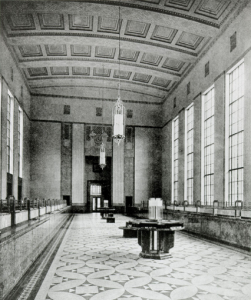
Hall Principale, Retrieved from https://c1.staticflickr.com/1/309/18123889283_0090f5c85b_b.jpg
URBAN HERITAGE: In addition to the values and cultural expression represented thought the different architectural components, the building’s presence on both Wellington and Sparks Streets functions as part of an urban organism as the nature of the site and its presence is integrated into the urban fabric through its symbolic and artistic value (Bandarian & Ores, 2012, p.10). In this sense, it was once an active witness to the everyday life, activity, and social and economic exchange that encapsulates experience and feelings (Federal Heritage Building Review Office. 1987). Whereas its culturally defining elements are symbolic in artistic value, their representations embodies the idea that there are personal and collective memories that are reflected in the sense of place (Brandarian & Ores, 2012, p.vii).
Based on the HUL Guidebook: Managing Heritage in Dynamic and Constantly Changing Urban Environments (2016), urban heritage can be assessed through elements such as historic and contemporary built environment, the land uses and patters of spatial organization, and visual relationships. This framework addresses the sustainability of social and cultural practices and values, and intangible dimensions of heritage that relate to diversity and identity. Conservation of the Historic Urban Landscape is achieved by taking into account the following criteria:
- To understand comprehensive surveys and mapping of the city’s natural, cultural and human resources;
- To reach a consensus using participatory planning and stakeholder consultation on what values to protect for transmission to future generations and to determine the attributes that carry these values;
- To assess vulnerability of these attributes to their socio-economic stresses and impacts of climate change;
- To integrate urban heritage values and their vulnerability status into a wider framework of city development, which shall provide indications of areas of heritage sensitivity that require careful attention to planning, design, and implementation of developments projects;
- To prioritize actions for conservation and development; and
- To establish the appropriate partnership and local management frameworks for each of the identified projects for conservation and development, as well as to develop mechanisms for the coordination of the various activities between different actors, both public and private.
The rehabilitation and adaptive reuse of efforts accomplished through the former Bank of Montreal project answer a majority of these requirements. For example, in regard to the second criteria, the former Bank of Montreal is under the holistic authority of the FHBRO and the NCC. The engineering and design architect have approached the rehabilitation of the building with careful consideration of the cultural elements that reflect the values and importance of the socio-economic relationship that once flourished in this location (Brandt, 2016, 11). Also under the fourth criteria, these efforts are a part of a larger systematic refurbishment and improvement of 99.5 million dollars to fix up the Parliamentary Precinct and the downtown core, which is led by Public Services (Ryckewaert, 2016). Furthermore, in relation to the fifth criteria, conservation has been the driving force of this project, and the heritage conservationist ensures that the materials, craftsmanship and integrity to ensure the significance of the place informed each process and phase of development (MTBA Associates Inc, 2017). Lastly in regard to the sixth criteria, the partnership between different actors allowed for the rehabilitating efforts of the former Bank of Montreal to be adequately assessed and developed by experts in their designated field of practice. This ensures that all the architectural and conservation needs have been met.
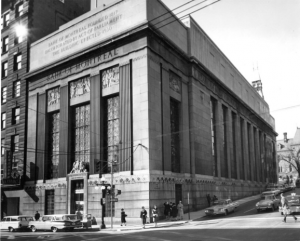
South Façade the Bank of Montreal Building, Retrieved from http://www.marketwired.com/
SUSTAINABILITY: Conservation efforts in conjunction with a desire to improve the overall performance of the building through the incorporation of sustainable elements appear to be driving forces in the rehabilitation of the former Bank of Montreal. Evidently there was a greater focus on environmental sustainability, however in preserving and adapting the building to be more energy efficient, the project developers simultaneous sustained certain aspects of cultural, social and economic sustainability. These sustainability efforts are cited from the Green Globe Canada New Construction Guidelines v.2 (2016) unless otherwise stated.

fully Glazed Atrium Connecting the Historic Banking Hall. Retrieved from https://www.canadianarchitect.com/
Environmental sustainability: As a means of addressing the environmental impact that buildings have on climate change, the thoughtful design of both the rehabilitation and new construction of the former Bank of Montreal reflect the stewardship of the project by understanding the environmental issues specific to the buildings location (Caroon, 2010, p.5). As such, the design incorporated energy efficient features to minimize its effect on the microclimate (Green Globes, 2016). Features such as a green roof, energy efficient lights and sensors, low-flow faucets and toilets, HVAC energy management, reduce overall embodied energy of the project, relation to transportation networks, using existing building material, using limestone to repair masonry and refurbish the interior, and re-appropriate teller counters into benches (Green Globes, 2016).
Considering that the Former Bank of Montreal was built around the time of World War II, it is categorized as ‘modern building’ and therefore presents unique challenges and interest in conservation (Parks Canada, 2016, p.41). In this sense, it possesses the opportunity for successful sustainability through processes of incorporating imbedded features in an attempt to introduce passive survivability (Caroon, 2010, p.10). As such, through the incorporation of existing elements, the heritable building and the new construction will benefit from their inherent sustainability from features like thermal mass, passive resilience, durable, robust and reusable materials, and embodied energy (Caroon, 2010, p.10). In this sense, certain features such as Daylighting allows the building to function despite modern energy systems, therefore through large windows, and light wells, daylighting helps to narrow the buildings footprint (Carroon, 2010, p.10). As a result, the building performs 21% better than Model National Energy Code with an estimated energy use of 9, 176 Gj/y (Green Globes, 2016). This approach to rehabilitating the existing structure mimics processes such as LAC and long-life/lose-fit where they take advantage of the embodied energies, rather than demolishing and using more energy to manage waste, and construct a new building (Caroon, 2010, p.7). In addition, the durability of the existing building often has minimal embodied energies since they don’t need to be frequently removes, replaces or disposed (Caroon, 2010, p.8).
Social and Cultural Sustainability: Evidently, there have been significant efforts to economically sustain the existing building and meet the future needs of upcoming generations with the new construction, however socially and culturally their sustainability efforts are less prominent. However, through the rehabilitation measures, there was an inherent gesture to respect the previous design as a way to contribute to the physical manifestations of different times and cultures on the streetscape (Caroon, 2010, p.47).
The adaptive reuse of this space, has both negatively and positively impacted its social and cultural sustainability. In the 1986 Heritage Character Statement, it was noted that its only function should be as a bank due to the relationship that was created between not only the bank and its clients, but also in relation to the adjacent streets and the connotations from the allegorical bas-reliefs (FHBRO, 1987). Not only did adaptively reusing this space disregard the suggestions of the heritage statement, but it also broke the connection between the public and this space. By transforming this space into an exclusive and relatively private ceremonial space, the adaptive reuse of this space puts into question its social accessibility. Since there was such a great effort in preserving the allegorical panels that symbolize a relation between the local economy and the people, it seems contradictory to have used this space for a program that limit public access. That being said, the efforts that were used in conserving the Art Deco allegorical panels on the exterior and the interior of the space reflect the efforts of cultural sustainability. These panels reflect Canadian values, symbolically enforcing a relationship between economic development and the local community.
MEASUREMENT: The environmental performance of this project was assessed through the Green Globes Rating System. Green Globes provides criteria to evaluate and rate the environmental performance of new and existing buildings, and interior fit-ups (Green Globes, 2016). It performs as a guide and an assessment tool to stimulate intellectual discussion (Carroon, 3020, p.90), and evaluates the performance of the building under four categories of building criteria through a 400 question survey (Green Globes, 2014). Depending on the number of points acquired, the Green Globes rating is given based on the final eco score in addition to the overall score that the building has obtained (Green Globes, 2014). The former Bank of Montreal proved to be an interesting example of Green Globs since it used both the New building construction for the Annex and the Atrium, as well as it rehabilitation of the heritage building. As such the New Building Construction Guidelines v.2 and the BOMA National Green Building Report (derivative of Green Globes Existing Building Module) were used in the assessment of this building.
The list of criteria as Stated in Green Globes Design for New Construction and Major Retrofits V.2 2014: Rating System and Program Summary (2014) is as follows.
- Project Management: assessed through integrated design, environmental management during construction, and commissioning (Green Globes, 2014).
- Site: assessed in terms of its development area, ecological impact, storm water management, the landscape, exterior light pollution and site innovation (Green Globes, 2014).
- Energy: assessed in terms of its performance, demand, measurement and verification, building envelope, lighting, HVAC systems, renewable energy, automobile use, innovation, and other equipment (Green Globes, 2014).
- Water: assessed in terms of consumption, cooling towers, boilers and water heaters, applications, treatment, alternative sources, metering, irrigation and innovation (Green Globes, 2014).
- Materials and Resources: assessed in regard to building assembly, interior fit-outs, re-use of existing structures, waste, service life plan, resource conservation, roofing and opening, foundation and water proofing, cladding, barriers and resource innovation (Green Globes, 2014).
- Emissions: assessing the effect of heating, cooling and the impact of janitorial equipment.
- Indoor environment: evaluating the ventilation, source control, lighting design and systems, the level of thermal massing and system control, and accounts comfort (Green Globes, 2014).
The Sir John A. Macdonald Building received 5 Green Globes for its excellence in each of the criteria classification. It received the following scored in regards to the assessment areas mentioned above (Green Globes, 2016)
- Project management: 100%
- Site: 93%
- Energy: 74%
- Water: 74%
- Resources: 91%
- Emissions: 100%
- Indoor Environment: 93%
Each of these criteria were assessed at the following four stages: Pre-design; Schematic Design; Construction Documents; and Post-Construction (Green Globes, 20160. Throughout the buildings, there are energy efficient features that have been used to specifically respond to the criteria of Green Globes. As such HVAC systems and energy management, energy efficient lighting and water fixtures, daylighting and sensor control, green rood and optimal orientation to optimize effect of microclimate, were all key contributors to the excellence in ecological friendly architecture and in improving the environmental sustainability of the site (Green Globes, 2016). The last stage is used as a final assessment to issue the final certificate (Green Globes, 2016).
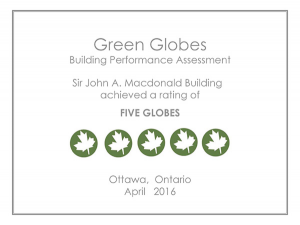
Green Globe Certificate, Retrieved from https://www.tpsgc-pwgsc.gc.ca/
The adaptive reuse of this space proved to be a successful method in attempt to repurpose this building. Without diminishing its value as a heritage site, the architecture and conservation efforts have harmoniously met the demands of the new building function, while simultaneously incorporating innovative features that have lead to the an ecological efficiency that has become a leading model within the Parliamentary Precinct.
REFERENCES
Books/Book chapters/Journal articles
- Brandarin, F., & Oers, R. (2012). The history Urban Landscape: Managing Heritage in an urban Century. Hoboken, NJ: Wiley Blackwell
- Carroon, J. (2010).Sustainable Preservation: Greening Existing Buildings. Hoboken, N.J.: Wiley.
- Federal Heritage Building Review Office. (1987). Heritage Character Statement. Retrieved from http://historicplaces.ca/en/
Policies and Reports
- Canadian Registrar of Historic Places. (n.d.) Bank of Montreal. Retrieved from http://historicplaces.ca/en/
- Federal Heritage Building Review Office. (1987). Heritage Character Statement. Retrieved from http://historicplaces.ca/en/
- Government of Canada, Public Works and Government Services Canada. & Parliamentary Precinct Branch. (2017). Rehabilitating the Sir John A. Macdonald Building. Retrieved from https://www.tpsgc-pwgsc.gc.ca/
- Green Globes. (2016). BMO Renovation, Sir John A. Macdonald Building. Retrieved from http://www.greenglobes.com/
- Green Globes. (2014). Design for New Construction and Major Retrofits V.2 2014: Rating System and Program Summary. Retrieved from http://www.greenglobes.com/
- Parks Canada. (2016). Building Resilience: Practical Guidelines for The Sustainable Rehabilitation of Buildings in Canada. Retrieved from http://historicplaces.ca/
- 15th World Conference of the League of Historic Cities. (2016). HUL Guidebook: Managing Heritage in Dynamic and Constantly Changing Urban Environments. Retrieved from http://historicurbanlandscape.com/
- Ryckewaert, L. (2016, Feb. 22nd). “‘It’s A Very Small Building, But Its Very Rich,’ New Hill Space Opens With Sir John A. Macdonald Building Addition”. The Hill Times. Retrieved from http://mtbarch.com/
Websites
- Brandt, M. T. (2016). Art & Architecture History Summary. Retrieved from http://mtbarch.com/
- EllisDon Construction and Building Services. (2016). Project Summary: Ottawa Sir John A. Macdonald BMO Bank. EllisDon. Retrieved from http://www.ellisdon.com/
- John G. Cooke & Associates LTD. (n.d). Bank of Montreal. John G. Cooke & Associates LTD Consulting Engineers. Retrieved from https://www.jgcooke.com/
- MTBA Associates Inc. (2017). Sir John A. Macdonald Building. MTBA Architecture Urbanism Conservation. Retrieved from http://mtbarch.com/
- National Capital Commission. (n.d.) About us. National Capital Commission. Retrieved from http://ncc-ccn.gc.ca/
- NORR. (2017). Sir John A. Macdonald Building: Ottawa, Ontario, Canada. NORR. Retrieved from http://norr.com/
- Ottawa Citizen. (2016). John A. Macdonald Building, Among Other Sites to Open its doors to the Public. Retrieved from http://ottawacitizen.com/
- Parks Canada (2017). Federal Heritage Building Review Office: Welcome. Federal Heritage Building Review Office. Retrieved from https://www.pc.gc.ca/
- Public Services and Procurement Canada. (2017). About PSPC. Public Services and Procurement Canada. Retrieved from https://www.tpsgc-pwgsc.gc.ca/
Banner image: View from the Atrium into the Banking Hall, DoubleSpace Photography. Retrieved from http://www.oaa.on.ca